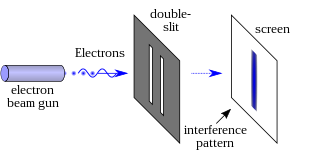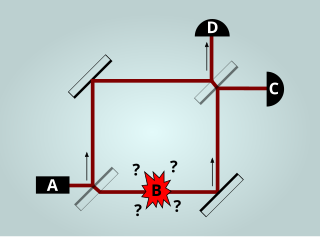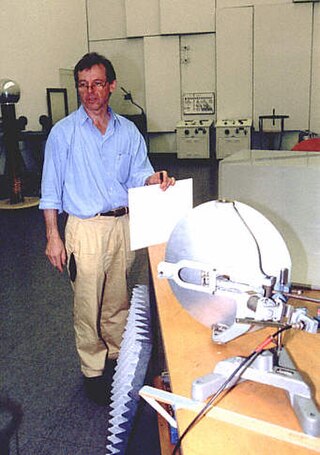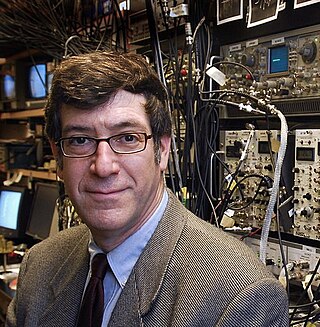Related Research Articles

In modern physics, the double-slit experiment demonstrates that light and matter can satisfy the seemingly-incongruous classical definitions for both waves and particles, which is considered evidence for the fundamentally probabilistic nature of quantum mechanics. This type of experiment was first performed by Thomas Young in 1801, as a demonstration of the wave behavior of visible light. At that time it was thought that light consisted of either waves or particles. With the beginning of modern physics, about a hundred years later, it was realized that light could in fact show both wave and particle characteristics. In 1927, Davisson and Germer and, independently George Paget Thomson and Alexander Reid demonstrated that electrons show the same behavior, which was later extended to atoms and molecules. Thomas Young's experiment with light was part of classical physics long before the development of quantum mechanics and the concept of wave–particle duality. He believed it demonstrated that Christiaan Huygens' wave theory of light was correct, and his experiment is sometimes referred to as Young's experiment or Young's slits.

The electron is a subatomic particle with a negative one elementary electric charge. Electrons belong to the first generation of the lepton particle family, and are generally thought to be elementary particles because they have no known components or substructure. The electron's mass is approximately 1/1836 that of the proton. Quantum mechanical properties of the electron include an intrinsic angular momentum (spin) of a half-integer value, expressed in units of the reduced Planck constant, ħ. Being fermions, no two electrons can occupy the same quantum state, per the Pauli exclusion principle. Like all elementary particles, electrons exhibit properties of both particles and waves: They can collide with other particles and can be diffracted like light. The wave properties of electrons are easier to observe with experiments than those of other particles like neutrons and protons because electrons have a lower mass and hence a longer de Broglie wavelength for a given energy.

Faster-than-light travel and communication are the conjectural propagation of matter or information faster than the speed of light. The special theory of relativity implies that only particles with zero rest mass may travel at the speed of light, and that nothing may travel faster.

Particle physics or high energy physics is the study of fundamental particles and forces that constitute matter and radiation. The fundamental particles in the universe are classified in the Standard Model as fermions and bosons. There are three generations of fermions, although ordinary matter is made only from the first fermion generation. The first generation consists of up and down quarks which form protons and neutrons, and electrons and electron neutrinos. The three fundamental interactions known to be mediated by bosons are electromagnetism, the weak interaction, and the strong interaction.

A photon is an elementary particle that is a quantum of the electromagnetic field, including electromagnetic radiation such as light and radio waves, and the force carrier for the electromagnetic force. Photons are massless, so they always move at the speed of light in vacuum, 299792458 m/s. The photon belongs to the class of boson particles.

Quantum mechanics is a fundamental theory in physics that provides a description of the physical properties of nature at the scale of atoms and subatomic particles. It is the foundation of all quantum physics including quantum chemistry, quantum field theory, quantum technology, and quantum information science.
This is a timeline of quantum computing.
Quantum optics is a branch of atomic, molecular, and optical physics dealing with how individual quanta of light, known as photons, interact with atoms and molecules. It includes the study of the particle-like properties of photons. Photons have been used to test many of the counter-intuitive predictions of quantum mechanics, such as entanglement and teleportation, and are a useful resource for quantum information processing.

Physics World is the membership magazine of the Institute of Physics, one of the largest physical societies in the world. It is an international monthly magazine covering all areas of physics, pure and applied, and is aimed at physicists in research, industry, physics outreach, and education worldwide.
Quantum mechanics is the study of matter and its interactions with energy on the scale of atomic and subatomic particles. By contrast, classical physics explains matter and energy only on a scale familiar to human experience, including the behavior of astronomical bodies such as the moon. Classical physics is still used in much of modern science and technology. However, towards the end of the 19th century, scientists discovered phenomena in both the large (macro) and the small (micro) worlds that classical physics could not explain. The desire to resolve inconsistencies between observed phenomena and classical theory led to a revolution in physics, a shift in the original scientific paradigm: the development of quantum mechanics.

Roy Jay Glauber was an American theoretical physicist. He was the Mallinckrodt Professor of Physics at Harvard University and Adjunct Professor of Optical Sciences at the University of Arizona. Born in New York City, he was awarded one half of the 2005 Nobel Prize in Physics "for his contribution to the quantum theory of optical coherence", with the other half shared by John L. Hall and Theodor W. Hänsch. In this work, published in 1963, he created a model for photodetection and explained the fundamental characteristics of different types of light, such as laser light and light from light bulbs. His theories are widely used in the field of quantum optics. In statistical physics he pioneered the study of the dynamics of first-order phase transitions, since he first defined and investigated the stochastic dynamics of an Ising model in a paper published in 1963. He served on the National Advisory Board of the Center for Arms Control and Non-Proliferation, the research arms of Council for a Livable World.

The Elitzur–Vaidman bomb-tester is a quantum mechanics thought experiment that uses interaction-free measurements to verify that a bomb is functional without having to detonate it. It was conceived in 1993 by Avshalom Elitzur and Lev Vaidman. Since their publication, real-world experiments have confirmed that their theoretical method works as predicted.

Daniel Frank Walls FRS was a New Zealand theoretical physicist specialising in quantum optics.

Günter Nimtz is a German physicist, working at the 2nd Physics Institute at the University of Cologne in Germany. He has investigated narrow-gap semiconductors and liquid crystals. His claims show that particles may travel faster than the speed of light when undergoing quantum tunneling.
In quantum mechanics, a weak value is a quantity related to a shift of a measuring device's pointer when usually there is pre- and postselection. It should not be confused with a weak measurement, which is often defined in conjunction. The weak value was first defined by Yakir Aharonov, David Albert, and Lev Vaidman, published in Physical Review Letters 1988, and is related to the two-state vector formalism. There is also a way to obtain weak values without postselection.

Mark George Raizen is an American physicist who conducts experiments on quantum optics and atom optics.
The Planck constant, or Planck's constant, denoted by , is a fundamental physical constant of foundational importance in quantum mechanics: a photon's energy is equal to its frequency multiplied by the Planck constant, and the wavelength of a matter wave equals the Planck constant divided by the associated particle momentum.
Zachary John Dutton is an American physicist who has worked on research centred mainly around cold atomic gases, EIT, low light level nonlinear optics, quantum memories, and coherent optical. Dutton graduated from Lindsay High School in Lindsay CA, and was awarded a BSc in physics from UC Berkeley in 1996. He was awarded his PhD in theoretical physics at Harvard University in 2000. His doctoral advisor was Prof.Lene Hau for his thesis entitled "Ultra-slow, stopped, and compressed light in Bose–Einstein condensates" He worked on a number of papers with Hau and Cyrus Behroozi, being amongst the first group to stop light completely. He undertook postdoctoral work at NIST–Gaithersburg with Dr. Charles Clark, prior to becoming a staff physicist at the Naval Research Lab in Washington. He conducted research centred mainly around cold atomic gases, EIT, low light level nonlinear optics, quantum memories, and coherent optical storage.

Andreas Wallraff is a German physicist who conducts research in quantum information processing and quantum optics. He has taught as a professor at ETH Zürich in Zürich, Switzerland since 2006. He worked as a research scientist with Robert J. Schoelkopf at Yale University from 2002 to 2005, during which time he performed experiments in which the coherent interaction of a single photon with a single quantum electronic circuit was observed for the first time. His current work at ETH Zürich focuses on hybrid quantum systems combining superconducting electronic circuits with semiconductor quantum dots and individual Rydberg atoms as well as quantum error correction with superconducting qubits.
Lindsay J. LeBlanc is a Canadian atomic physicist. She is an associate professor of physics at University of Alberta and the Tier 2 Canada Research Chair for Quantum Simulation with Ultracold Quantum Gases. Her work involves quantum simulation, quantum memory, and developing hybrid quantum systems.
References
- 1 2 Guy, Allison (17 July 2015). "Driven By The Big Question: "Why?"". Research2Reality. Retrieved 30 August 2023.
- 1 2 3 Luke, Kim. "U of Toronto experiment named top breakthrough of 2011 by Physics World". University of Toronto. Retrieved 30 August 2023.
- 1 2 3 Bahl, Aanya (8 September 2020). "U of T physicists discover that quantum tunnelling is not instantaneous". The Varsity. Retrieved 30 August 2023.
- 1 2 "Aephraim Steinberg – Division of the Vice-President & Provost" . Retrieved 31 August 2023.
- ↑ Steinberg, Aephraim Matthew (1994). When Can Light Go Faster Than Light?: The Tunneling Time and Its Sub-femtosecond Measurement Via Quantum Interference (Thesis). hdl:2027/uc1.c3385816. OCLC 928069982. ProQuest 304079188.[ page needed ][ non-primary source needed ]
- 1 2 "Deborah Jin Award for Outstanding Doctoral Thesis Research in Atomic, Molecular, or Optical Physics". aps.org. Retrieved 31 August 2023.
- ↑ Steinberg, A. M.; Kwiat, P. G.; Chiao, R. Y. (2 August 1993). "Measurement of the single-photon tunneling time". Physical Review Letters. 71 (5): 708–711. Bibcode:1993PhRvL..71..708S. doi:10.1103/PhysRevLett.71.708. PMID 10055346. S2CID 31009201.[ non-primary source needed ]
- ↑ Chiao, Raymond Y.; Kwiat, Paul G.; Steinberg, Aephraim M. (1993). "Faster than Light?". Scientific American. 269 (2): 52–60. Bibcode:1993SciAm.269b..52C. doi:10.1038/scientificamerican0893-52 . Retrieved 31 August 2023.
- ↑ cifar.ca https://cifar.ca/research-programs/quantum-information-science/ . Retrieved 31 August 2023.
{{cite web}}: Missing or empty|title=(help) - ↑ Levine, Romi. "From fighting fungus to improving innovation: U of T researchers lead CIFAR interdisciplinary research programs". University of Toronto. Retrieved 31 August 2023.
- 1 2 Johnston, Hamish (16 December 2011). "Physics World reveals its top 10 breakthroughs for 2011". Physics World. Retrieved 30 August 2023.
- 1 2 3 Chung, Emily (2 June 2011). "'Impossible' physics feat traces path of light". CBC. Retrieved 31 August 2023.
- ↑ Commissariat, Tushna (3 June 2011). "The secret lives of photons revealed". Physics World. Retrieved 30 August 2023.
- ↑ Palmer, Jason (5 September 2012). "Heisenberg uncertainty principle stressed in new test". BBC News. Retrieved 30 August 2023.
- ↑ Brumfiel, Geoff (11 September 2012). "Quantum uncertainty not all in the measurement". Nature. doi:10.1038/nature.2012.11394. ISSN 1476-4687. S2CID 124744615.
- ↑ Barss, Patchen (14 August 2019). "University of Toronto physicists harness neglected properties of light". Faculty of Arts & Science. Retrieved 30 August 2023.
- ↑ "Is the Force with Us? Our Professor Aephraim Steinberg helps explain in Through the Wormhole!". www.physics.utoronto.ca. Retrieved 30 August 2023.
- 1 2 "Aephraim Steinberg appointed University Professor". University of Toronto. Retrieved 31 August 2023.
- ↑ Harris, Margaret (28 December 2020). "A year of quantum highlights". Physics World. Retrieved 31 August 2023.
- ↑ "Aephraim M. Steinberg". cifar.ca. Retrieved 30 August 2023.
- ↑ "Fellows Search | Optica". www.optica.org. Retrieved 31 August 2023.
- ↑ "APS Fellow Archive". www.aps.org. Retrieved 27 May 2022.
- ↑ Government of Canada, Natural Sciences and Engineering Research Council of Canada (28 June 2016). "NSERC – E.W.R. Steacie – Winners". Natural Sciences and Engineering Research Council of Canada (NSERC). Retrieved 30 August 2023.
- ↑ "Funding Opportunities | Connaught Fund". connaught.research.utoronto.ca. Retrieved 31 August 2023.
- ↑ "Press Releases". services.cap.ca. Retrieved 27 May 2022.
- ↑ "Past Award Winners | The Royal Society of Canada". rsc-src.ca. Retrieved 30 August 2023.
- ↑ "Polanyi Prize Winners". Council of Ontario Universities. Retrieved 31 August 2023.